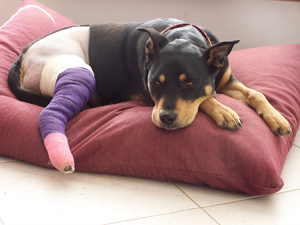Humans and other mammals share an amazing and intricate mechanism for healing from a wound or infection. The first part of the healing process in the inflammatory response, which is the most noticeable and uncomfortable. Inflammation is an important sign that the body is trying to heal itself, but inflammation that lasts for too long can impede recovery. Here’s a rundown of the inflammatory response to help you better understand your pet’s body and how Assisi can help.
Tissue damage can be the result of a wound, heat, chemical irritation, or an infection. Injured tissue immediately sends chemical signals that initiate the healing process. Firstly, the capillaries leading away from the injured area to constrict, and the arterioles leading to the site dilate to increase blood flow to the area. At the same time, the permeability of these capillaries is increased, allowing white blood cells, other cells and fluids to pass through to the injured area. These fluids have a higher protein content than those normally found in tissues which attracts water to the area and cause further swelling.
 The cells that migrate to the area perform a number of “first response” tasks. They to remove debris, break down dead cells, and kill bacteria. This activity is marked by the five symptoms of the inflammatory response: swelling, pain, redness, heat, and immobility.
The cells that migrate to the area perform a number of “first response” tasks. They to remove debris, break down dead cells, and kill bacteria. This activity is marked by the five symptoms of the inflammatory response: swelling, pain, redness, heat, and immobility.
These uncomfortable symptoms mean that the wound is being prepared for the next stages of recovery. Inflammation will remain as long as there is work for these cells to do. Afterward, the granulation stage will start rebuilding tissue.
Acute inflammation, such as you get after an injury or surgery, will be most painful in the first three days. It may persist in for up to a week depending on the severity and health of the animal. At the same time, red, painful, swollen tissue may be a sign of infection, so contact your veterinarian if you feel anything is out of the ordinary.
Chronic inflammation comes from repeated irritation (such as from over-exercise), degenerative arthritis, allergies, a continued infection, or even the body beginning to attack itself. This may need an intervention of surgery, chronic pain management, or physical therapy to turn off the inflammatory response and help your pet.
Animals, unfortunately, can’t tell us when they are hurting. You may be able to feel swelling and heat in your animal’s limbs. Reduced mobility can be spotted by observing your pet’s behavior. Difficult moving from a standing to laying down position, or any yelping, can be an early sign of arthritis. If your pet has any of these symptoms, take him to your vet for an expert opinion.
The Assisi device can help your pet recover from surgery, trauma, or other inflammation by acting directly on the inflammatory response. Instead of suppressing inflammation, which can ultimately interfere with wound healing, Assisi’s microcurrents stimulate the process by increasing nitric oxide (NO) production. NO is essential to many body functions such as the rebuilding of capillaries (angiogenesis) and controlling localized blood pressure (and therefore swelling). tPEMF microcurrents stimulate the cascade of molecule binding that leads to the release of NO. The proliferation of NO speeds along the recovery process by “supercharging” the system.
More questions? Email us at info@assisianimalhealth.com
This article is for general information only and not intended to replace or stand-in for the advice of your veterinarian.
